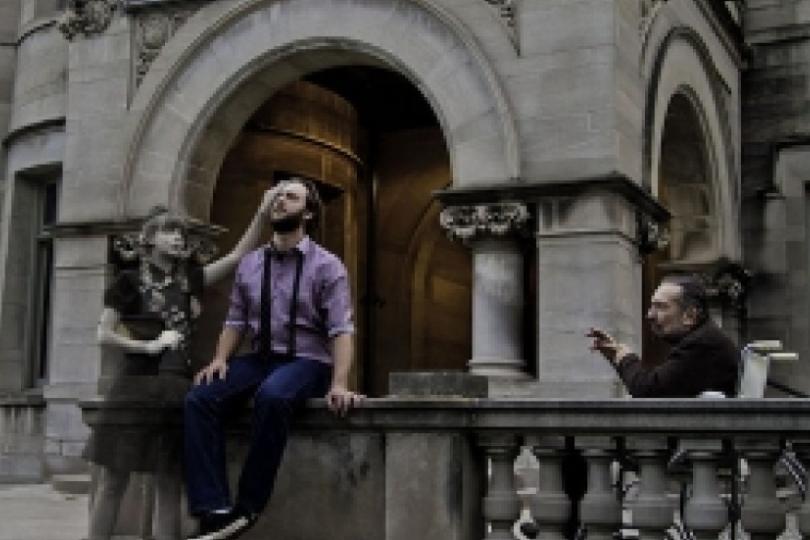Between Act II and Act III of the Nimbus Theatre’s production of Strindberg’s
Ghost Sonata is one of the most surprising scene changes I have ever seen. In one simple movement that knocked me back and made my heart pound, I finally understood exactly what kind of effect this play was going for. It was a rush: but it’s an elusive one, and one that might not be universally appealing.
You see, August Strindberg had some psychotic attacks in the mid-1890’s, and by the time he wrote
Ghost Sonata in 1907, he was firmly committed to a style called
Expressionism. You can think of this as the theatrical incarnation of Edvard Munch’s unnerving painting
The Scream, with the goal of bringing the audience along on an intense, nightmarish journey of the soul. Unlike in Naturalism, Expressionism’s more accessible and realistic predecessor, an Expressionist play is like walking into a dream. Emotions are heightened and the supernatural becomes a way of accessing the subconscious, with the result that the plot seems bizarre and the acting is far more over-the-top than we’re used to today.
So, depending on how you look at it,
Ghost Sonata’s weirdness is either oddly fun or deeply alienating. In this particular production, it’s a little bit of both.
Strong elements
Director and set designer Zach Morgan gives the audience cues for how to view the show, both in the program notes and as we wait for the play to begin. A video projection of water overlays the set, a grotesquely oversimplified manor house, and a three-piece ensemble plays music off to one side. The combination of the water and the music makes it clear that we are meant to be carried off with the play and sucked into its shifting moods.
Composer Charlie McCarron, who wrote an original score for this production, did an excellent job capturing the play’s various moods. The attention to music is particularly welcome in a play called “Sonata,” which does, in fact, parallel the musical form pretty closely. It is in three short acts and is performed without an intermission. Like
a musical sonata, the first act provides exposition to both the play’s content and its tone; the second is slower-paced and more free-form; and the third is a more tightly-wound and frenetic scherzo.
I am giving you a lot of context here, because despite having a very clear idea of what it wants to achieve, the production itself does not always reach the heights that it is aiming for. The result is a viewing experience that is more muddled than it needs to be.
Ghost Sonata is most satisfying in the moments of restraint where a psychological or emotional state is allowed to crystallize and take shape. There are several supernatural characters in the play – the ghost of a Girl Scout, a mummy in a closet, and a vampire cook –whose allegorical functions are fairly obvious, but they remain interesting because of the emphasis on their most uncanny qualities. Karen Bix plays the Mummy with great finesse (if I can use that word to describe a woman who starts Act II talking like a parrot). As she gradually reclaims her personhood, Bix modulates her voice to great effect; her forays in and out of the safety of her wrappings allow us to see the Mummy as a feminist figure without losing any of the character’s unsettling weirdness. Charles Numrich plays the Old Man with the casually-veiled threat of a successful manipulator, and his scenes with Bix, in particular, have an electric push-pull dynamic to them.
There is a funny side to some of the play’s nightmarish and supernatural qualities, too. Shannon Troy Jones and Mark L. Mattison, as the “help”, turn an Act II dinner service into a finely-tuned and understated comedy of menace. And after the initial shock of the grotesque appearance of the Cook, Cate Jackson’s portrayal is less frightening and more like a cafeteria worker gone wrong. (The trouble is that I’m not sure that the character was actually supposed to be funny.)
Jarring elements
What didn’t ring true for me were the more melodramatic scenes, particularly Andrew Sass’s hysteria in the third act as the overwhelmed Student. This is where some context about expressionism can be helpful, since heightened acting was part of the style’s rebellion against realism. But there is melodrama and there is shouting, and the actors too often fall into the trap of equating higher drama with higher volume. A well-placed outburst can increase momentum, but too much of it and the energy becomes hard for the audience to sustain.
Nimbus has collaborated with Danielle Blackbird to create an all-new translation of the play, which is largely successful. I have no point of reference to either the original Swedish or to any other translations of the play, but I enjoyed Blackbird’s powerful turns of phrase that make the text immediately compelling. Blackbird and Morgan have incorporated some modern technology into the production, which feels slightly (but inoffensively) anachronistic – not because the play itself is particularly specific to 1907, but because its tone is so gothic that the sight of a cell phone is jarring.
It was a brave choice to stage this play since
Ghost Sonata requires its audience to lay a lot of its expectations about theater to the side. It isn’t meant to be cohesive, and its characters are not psychologically interesting on an individual level. Instead, the play is a warped tapestry illustrating Strindberg’s general philosophy that people are awful and life is hell. (For more on that, I highly recommend
Strindberg and Helium.) It’s a bitter pill, and the production’s unevenness doesn’t help.
In spite of the shouting, though, the play’s moments of delicious weirdness make this strange, destabilizing funhouse an interesting place to explore.





